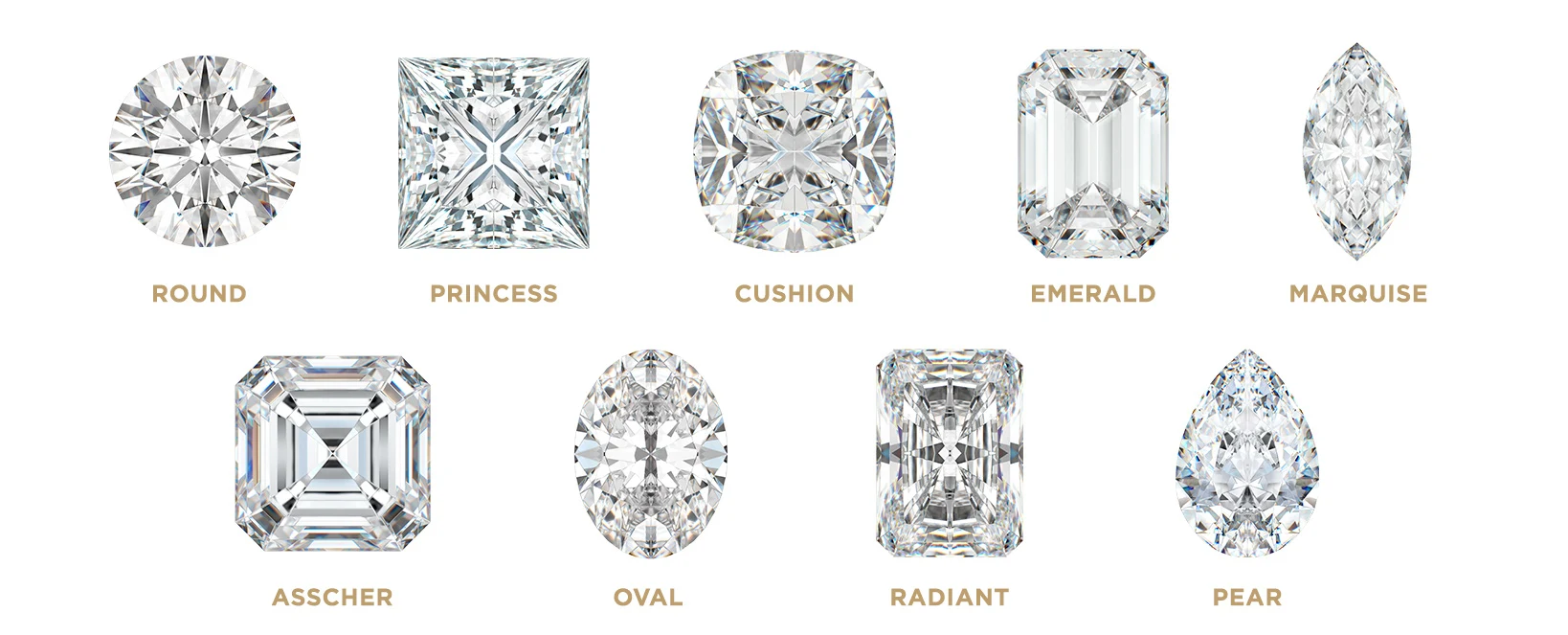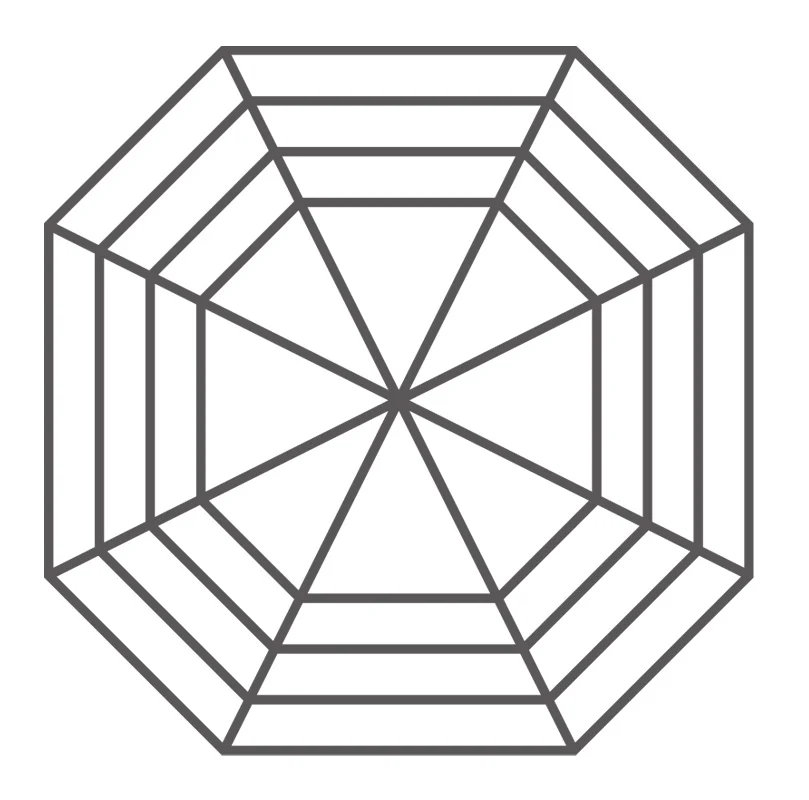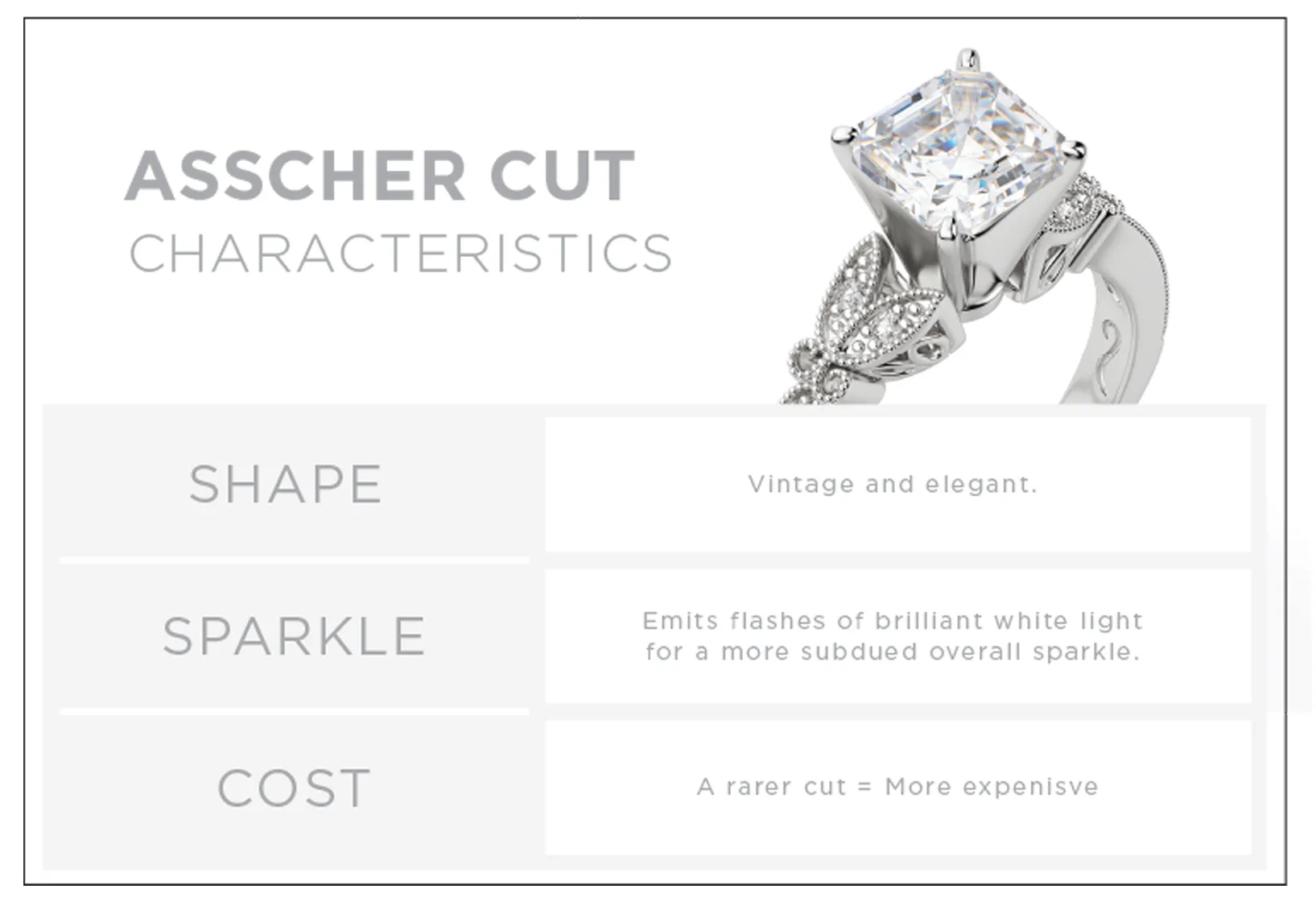Asscher vs Cushion Cut Diamonds: What’s the Difference?
December 12th, 2023 / Alese Oldenburg
Every single diamond is unique, but did you know there are more than a dozen varieties of diamond cut? Many are familiar with the most popular, the round brilliant cut diamond, and other favorites, including the princess cut, emerald cut, and oval cut, but there are even more stunning diamond shapes, including the lesser-known radiant cut and marquise cut. You can compare how all of these cuts look at different carat sizes in our diamond carat size chart.
 The list doesn’t end there, even. Today we’re comparing two diamond cuts that have an almost square shape: Asscher cut vs cushion cut.
The list doesn’t end there, even. Today we’re comparing two diamond cuts that have an almost square shape: Asscher cut vs cushion cut.
The Asscher diamond and the cushion diamond are distinct diamond shapes, but they do have some similarities as well as some key differences. When it comes to selecting the right diamond for you, knowing the differences between similar shapes can be extremely helpful and assist you in making the right choice. Read on to discover the differences between the Asscher cut diamond and the cushion cut diamond and uncover which one is the perfect fit for your engagement ring.
What is Diamond Cut?
Diamond cut is one of the critical components of diamond quality. Diamond quality is traditionally evaluated in four parts, commonly referred to as the 4Cs of diamond. The 4Cs are Clarity, Carat, Color, and Cut, each of which is graded on a scale. The cut is graded using a range from Excellent (or Ideal) to Poor.
Arguably, the diamond cut is the most important of the 4Cs. Without a quality cut, the diamond won’t have optimal symmetry or sparkle—it is the basis of the diamond’s beauty.
 Many people confuse diamond cut with diamond shape, and while the two are related, they are not the same. For instance, there may be 10 diamonds that are oval in shape with 4 or 5 different cuts. Every distinct diamond shape, though, has an ideal cut, that is, the cut that maximizes the sparkle and symmetry of that shape.
Many people confuse diamond cut with diamond shape, and while the two are related, they are not the same. For instance, there may be 10 diamonds that are oval in shape with 4 or 5 different cuts. Every distinct diamond shape, though, has an ideal cut, that is, the cut that maximizes the sparkle and symmetry of that shape.
When a diamond has an “excellent” or “ideal” cut, its brilliance and beauty are unmatched. For the sake of this comparison, we will use “Asscher cut” and “cushion cut” to describe the unique shapes in their ideal cut. These stone shapes also come in the form of diamond simulants like the Nexus Diamond™ alternative.
What is an Asscher Cut Diamond?
Discover the beautiful Asscher cut diamond… a diamond cut so well it has multiple names. But what is an Asscher cut diamond?—a square-shaped gem renowned for its precision and step-cut facets. This vintage-inspired cut, also known as a square emerald cut, captivates with a timeless charm. The Asscher cut’s distinct play of light and reflections sets it apart as a radiant work of art. Delve into its rich history and uncover the exceptional traits that define its uniqueness. With multiple names to its credit, the Asscher cut is a symbol of elegance and craftsmanship. Its mesmerizing appeal transcends time, making it a cherished gem in the world of fine jewelry. Discover the beauty and sophistication encapsulated within the allure of an Asscher cut diamond.
History of Asscher Cut
The captivating history of the Asscher cut diamond traces its roots back to 1902 when the Asscher Brothers, prominent diamond cutters from Holland, unveiled this exceptional diamond shape. The original Asscher cut, characterized by its distinctive square shape and 58 precisely arranged facets, was an immediate testament to the brothers’ commitment to innovation and precision in diamond cutting. Its unique step-cut pattern and symmetrical design set it apart, making it a sought-after choice for those who appreciate vintage charm and timeless elegance.
 Over time, the legacy of the Asscher cut evolved, giving rise to the Royal Asscher Cut—an enhanced version that pushed the boundaries of brilliance with an impressive 74 facets. This modern iteration builds upon the classic design, creating a breathtaking display of light reflection and ensuring that the Asscher cut remains at the forefront of sophistication in the world of fine jewelry. The Asscher cut’s enduring popularity attests to its timeless allure and the enduring legacy of the Asscher Brothers, who, over a century ago, revolutionized the diamond-cutting landscape with their visionary craftsmanship.
Over time, the legacy of the Asscher cut evolved, giving rise to the Royal Asscher Cut—an enhanced version that pushed the boundaries of brilliance with an impressive 74 facets. This modern iteration builds upon the classic design, creating a breathtaking display of light reflection and ensuring that the Asscher cut remains at the forefront of sophistication in the world of fine jewelry. The Asscher cut’s enduring popularity attests to its timeless allure and the enduring legacy of the Asscher Brothers, who, over a century ago, revolutionized the diamond-cutting landscape with their visionary craftsmanship.

The Asscher cut diamond is an octagon, that is, it has eight sides, four of which are elongated, and four of which are truncated corners, giving it a square-like shape. Within this unique silhouette, four sides are elongated, while the remaining four showcase truncated corners, contributing to its intriguing square-like form. This exquisite cut is renowned for its straight facets, also known as “step cuts,” which align with precision, akin to an emerald cut diamond. The clean lines and classic aesthetics of the Asscher cut lend it a timeless appeal that can effortlessly transition between a vintage and modern aesthetic, depending on the chosen setting.
Often likened to a “square emerald” due to its similarly shaped facets and truncated corners, the Asscher cut boasts a singular charm that sets it apart in the realm of diamond shapes. Its square nature invites comparisons to the princess cut diamond, creating a captivating dialogue between two distinct but equally stunning cuts. Whether set in a vintage-inspired or contemporary setting, the Asscher cut diamond exudes sophistication, making it a versatile choice that transcends the boundaries of time and style.
Unique Traits of Asscher Cut
The Asscher Cut diamond captivates with its geometric precision and Art Deco charm. This unique gem boasts a distinct personality, characterized by its octagonal shape, captivating fire, and timeless elegance. Let’s delve into the specific traits that set the Asscher Cut apart:
- A Geometric Masterpiece: Step into the world of Art Deco with the Asscher Cut. Defined by its meticulously crafted step-cut facets, this diamond boasts a unique octagonal shape with cropped corners. This geometric precision exudes an air of sophistication, instantly capturing the essence of the Art Deco era.
- Beyond Brilliance: While the step-cut faceting might suggest a subdued brilliance, the Asscher Cut surprises with its remarkable fire and sparkle. The large, flat facets reflect light in a mesmerizing way, creating an enchanting interplay of internal light that captivates the eye.
- A Modern Twist: The Asscher Cut’s octagonal shape offers a contemporary twist on the classic square diamond. This distinctive form sets it apart from other diamond cuts, adding a touch of individuality and a modern edge to any jewelry piece. Whether you’re drawn to its Art Deco origins or its modern appeal, the Asscher Cut promises to be a conversation starter and a timeless treasure.
- Unique Light Performance: The Asscher Cut’s brilliance extends beyond its fire. The unique interplay of light and shadow created by its faceting adds depth and visual intrigue. This captivating characteristic not only enhances its brilliance but also creates an illusion of larger size, making it a captivating option for those seeking a breathtaking diamond without compromising on budget.
What is a Cushion Cut Diamond?
A gem celebrated for its brilliant sparkle and plush, rounded appearance. Universally flattering, this cut seamlessly blends vintage charm with modern elegance, making it a beloved choice for timeless engagement rings. With its rounded corners and ample facets, the cushion cut exudes sophistication, capturing the essence of a bygone era. Beyond its visual appeal, the cushion cut diamond carries a rich history, entwined with the evolution of diamond cutting techniques. Uncover the secrets behind its unique facets and traits, showcasing the meticulous artistry that elevates this cut to a symbol of enduring beauty and charismatic elegance.
History of Cushion Cut
 This cut was once called the “old mine cut” because it dates back to the 1700s, making it one of the oldest diamond cuts, when it was predominantly discovered in the old mines in Brazil where it was cut with the intention of preserving much of the raw diamond. The original cut has changed along with diamond cutting technology, but the modern cushion cut still preserves much of the raw diamond, making it much more affordable than a round brilliant cut.
This cut was once called the “old mine cut” because it dates back to the 1700s, making it one of the oldest diamond cuts, when it was predominantly discovered in the old mines in Brazil where it was cut with the intention of preserving much of the raw diamond. The original cut has changed along with diamond cutting technology, but the modern cushion cut still preserves much of the raw diamond, making it much more affordable than a round brilliant cut.

True to its name, a cushion cut diamond looks a bit like a pillow cushion. It’s square or rectangular in shape with rounded corners that almost make it seem to puff up in the middle. When square, its rounded corners are the main thing that separates the cushion cut diamond and princess-cut ring.
There are two types of cushion cut diamonds: the crushed ice cushion cut and the chunky cushion cut. Their appearance differs mainly in their faceting pattern. A crushed ice cut cushion will have many tiny facets in the center of the diamond that give it that crushed ice look, while a chunky cushion cut will have a wider faceting pattern that is more similar to that of a round brilliant cut.
Unique Traits of Cushion Cut
The Cushion Cut diamond is a captivating gem, revered for its unique blend of softness and brilliance. Its alluring shape, distinctive faceting, and versatile nature make it a timeless treasure that transcends trends and generations. Let’s explore the specific traits that set the Cushion Cut apart:
- A Romantic Silhouette: Imagine a soft, inviting pillow. The Cushion Cut embodies this very essence with its graceful rectangular shape, gently rounded corners, and romantic aura. This captivating form evokes timeless elegance, making it a sought-after choice for engagement rings and special occasion jewelry.
- Multifaceted Brilliance: With a typical 58-facet configuration, the Cushion Cut showcases a mesmerizing interplay of light and fire. The interplay creates a dazzling spectacle, with each facet capturing and reflecting light in a unique way. This captivating brilliance is further enhanced by the high crown and shallow pavilion, creating a breathtaking display of sparkle.
- A Shape that Adapts: The Cushion Cut’s versatility is one of its most celebrated traits. Its charming silhouette seamlessly blends with various jewelry styles, from vintage to contemporary, effortlessly adding a touch of timeless beauty. Whether you envision it as the star of a modern solitaire setting or nestled within the embrace of a three-stone design, the Cushion Cut’s adaptability ensures it becomes a cherished part of your personal style.
Asscher vs Cushion Cut Diamonds
Shape Variation
While both Asscher and cushion cut diamonds can be square in shape, cushion cut diamonds can also be rectangular. This isn’t the only variation, though. Cushion cut diamonds have rounded corners, while Asscher cut diamonds have truncated corners that appear more like flat edges. When the corners of the diamond are covered with prongs, as they often are in an engagement ring setting, this difference is less noticeable.
 The difference in shape does give each cut a unique essence, though. Cushion cut diamonds will appear more soft and romantic, while Asscher cut diamonds will appear more vintage and elegant.
The difference in shape does give each cut a unique essence, though. Cushion cut diamonds will appear more soft and romantic, while Asscher cut diamonds will appear more vintage and elegant.
Sparkle Quality
Step cut diamond shapes including the Asscher, aren’t known for their sparkle. Instead, they emit flashes of brilliant white light for a more subdued overall sparkle. Meanwhile, cushion cut diamond shapes, like other brilliant cut shapes, catch much more light and reflect it in a fiery colored fashion, making them appear much sparklier. Keep in mind, a crushed ice cushion cut will sparkle more than the chunky cushion cut.
The difference in sparkle also makes a difference when it comes to clarity. While the sparkle of cushion cut diamonds enables them to hide imperfections quite easily, this isn’t the case for Asscher cuts. The arrangement of facets is like a window into the diamond, which not only creates a different type of sparkle but makes any imperfections quite visible.

Cost Difference
Compared to cushion cut diamonds, Asscher cut diamonds are the rarer of the two, and, as rarity increases, so does cost. However, the difference in cost isn’t substantial, and you may very well be able to find a similarly priced cushion and Asscher cut diamonds, especially if you shop lab grown diamonds or diamond simulants.
Which Diamond Cut is Best?
Ultimately, the choice between the Cushion Cut and the Asscher Cut depends on your personal preferences and desired aesthetic. If you yearn for a touch of romance and timeless elegance, the Cushion Cut beckons with its soft silhouette and captivating brilliance. If you seek a diamond with Art Deco charm and a modern edge, the Asscher Cut awaits to enthrall you with its geometric precision and captivating light performance.
No matter which cut you choose, both the Cushion Cut and the Asscher Cut offer a unique and captivating diamond experience. Each one holds the potential to become a cherished heirloom, forever reflecting your individual style and illuminating your life with its timeless beauty.
Shopping for an Asscher Cut Diamond
Pictured: The Barcelona Asscher Cut Engagement Ring
To get the most visually pleasing Asscher cut engagement ring, there are a few things to keep in mind. Look for a stone with a higher grade when it comes to both clarity and color since the cut of this diamond will reveal any inclusions or colors the diamond has. Selecting an Asscher cut diamond requires extra attention to clarity and color. The large, flat facets amplify any imperfections, making a VS2 or higher clarity grade ideal. Color is equally important, as the step-cut facets exaggerate it. Opt for near colorless (D-F) for maximum brilliance, or consider G-H if budget is a concern.
Cut plays a crucial role in an Asscher diamond’s beauty. Look for specific crown height, table size, and depth proportions, along with excellent polish and symmetry grades. Choose either no or faint fluorescence to avoid a milky appearance. Remember, the ideal diamond goes beyond just specifications; it should resonate with your personal style and evoke emotion.
Shopping for a Cushion Cut Diamond
Pictured: The Timeless Cushion Cut Engagement Ring
It’s important to keep in mind that not all cushion diamonds are created equal. There are a few essential qualities to look for when shopping for a cushion cut diamond for an engagement ring.
The chunky cushion will have less fire (that colorful reflection of light) than the crushed ice version, and it will likely be more expensive because it is typically cut from a higher quality diamond. However, the chunky version will be more brilliant and show colorless. It’s also important to shop for a cushion cut diamond with the length-to-width ratio you prefer in mind since this cut can come in both square and rectangle shapes.
Both Asscher and cushion cut diamonds are beautiful on their own and beautiful choices for an array of diamond jewelry. For engagement rings, whether you want a halo setting, accent diamonds, or all of the above, both of these options are versatile enough to pair with the setting that suits your style. Once you have decided which shape speaks to you the most, you can browse our collection of engagement rings to find the perfect setting to match.
Sources:
Cushion Cut vs. Princess Cut
https://www.diamonds.pro/education/asscher-cut/Asscher Cut Diamond Buying Guide
https://4cs.gia.edu/en-us/blog/cushion-cut-diamond-old-new-classic
*Here at Diamond Nexus, we strive to provide valuable information while being clear and honest about our products. The Nexus Diamond™ alternative is a patented lab created diamond simulate that, among all simulants, most closely imitates the look, weight and wear of a diamond, with two exceptions – it is absolutely perfect in every way, and it costs significantly less. Price points and environmental facts expressed in this blog were taken from popular online retailers and may vary. Learn more about the environmental impact of mining by visiting our blog.



